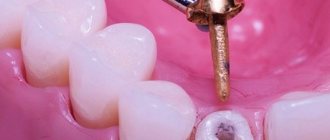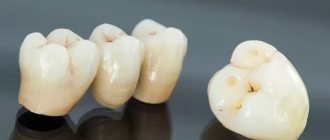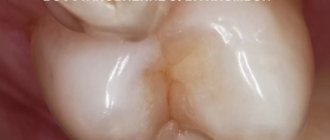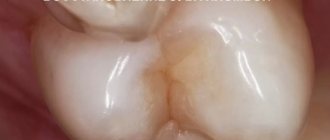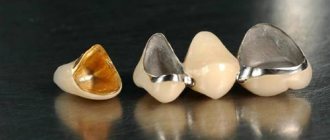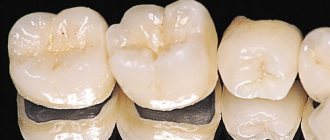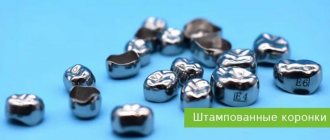Bridge prosthetics is a type of dental treatment. This technique is actively used in modern dentistry. A dental bridge is recommended if several adjacent teeth are severely damaged or missing. This is a permanent structure that consists of several artificial teeth connected in a row. The prosthesis is fixed to the supporting molars, which are located on both sides of the destroyed ones. It can also be attached to specially installed implants.
Dental bridge or bridge-like dentures: what they are, how they are installed, possible problems
Bridge and bridge-like structure are all synonyms that mean the same term. Its configuration resembles an arch on 2 or more supports. Teeth or implants can be used as supporting elements. The appearance of the bridge closely imitates natural teeth in shape and color. The parts that rest on healthy molars are called crowns. They look like caps. Installation benefits:
- have a natural appearance;
- allow you to completely restore chewing function;
- maintaining diction;
- minimum period of addiction – from 8 to 12 hours;
- affordable price.
It is recommended to install a bridge immediately after the removal of a natural molar. If this is not done, problems may arise in the future. For example, facial asymmetry, receding gums, displacement of adjacent teeth, gum infection, etc.
How much does it cost to cure a wisdom tooth?
In Moscow dentistry, the price of wisdom tooth treatment depends on the specific disease and the chosen treatment method. It is believed that treatment of lower wisdom teeth is more expensive, but this is only partly true. Removing the lower “eights” can actually cost a lot of money, since the bone tissue in the lower jaw is denser, so it becomes more difficult to remove an impacted tooth.
| Treatment of wisdom teeth | Price |
| Treatment of simple caries | from 2,500 rubles |
| Treatment of complex caries | from 4,000 rubles |
| Treatment of pulpitis | from 6,000 rubles (depending on the number of channels) |
| Easy removal | from 2,000 rubles |
| Difficult removal | from 6,000 to 12,000 rubles |
What is a dental bridge made of: which dental bridges are better?
A dental bridge can be made from:
- plastics, metal-plastics;
- metal, metal ceramics;
- zirconium oxide;
- aluminum or ceramics.
Let's take a closer look at which prostheses are the most durable? Structures made of zirconium oxide or aluminum are the most durable. Oxides are strong and reliable materials. They can be used to create long dental bridges (from 4 crowns or more). These products will help you achieve an aesthetic smile (they look almost no different from natural teeth); you can install this bridge on your front and/or chewing teeth. Another plus is the long service life (more than 20 years). A distinctive feature of oxides is strength. Very thin structures can be created from this material, thanks to which the supporting molars require less grinding.
The second most reliable one is a bridge made of metal ceramics. This type of prosthetics is affordable and looks very aesthetically pleasing. The structure is securely fixed. However, due to the presence of a hard and voluminous metal base, the supporting molars lend themselves to fairly strong grinding.
Budget option - plastic structures. This type of prosthetics is designed for no more than 3 years. The plastic coating is very brittle and can easily crack under stress. Also, over time, plastic can change color and size when exposed to external substances.
Installation of a prosthetic bridge on teeth: contraindications and indications
Indications:
- The presence of anomalies, extensive defects of the dentition. Most often they appear as a result of dental diseases or injuries.
- Missing one molar. In this situation, the structure consists of 2 supporting crowns, and an artificial element is located between them.
- The need to restore 1 or more front sections. Prosthetics are performed only if there are healthy supporting teeth.
- Restoration of chewing function. Crowns are installed to reduce the load on adjacent teeth.
Contraindications:
- bruxism;
- malocclusion;
- periodontal disease;
- increased abrasion of enamel;
- poor oral hygiene;
- diseases of bone tissue and blood;
- presence of mental disorders;
- exacerbation of chronic diseases.
Contraindications such as malocclusion, gum disease, and exacerbation of diseases can be treated. Prosthetics are possible only after all dental problems have been eliminated. Before placing a bridge on the teeth , the dentist must conduct a thorough diagnosis of the oral cavity and prescribe treatment (if necessary). Next, the smile restoration technique is determined.
Types of dental bridges by design
A dental bridge is distinguished by:
- the material used;
- degree of interaction with the mucous membrane;
- manufacturing method.
Today there are 4 types of bridges:
- Traditional bridge. It is a one-piece ceramic or metal-ceramic structure. This method is the most popular for prosthetics. Neighboring molars are filed down and crowns are placed on them, with an artificial tooth between them.
- Cantilever prosthesis. Recommended for installation if two teeth are missing in a row. The structure is attached only on one side using 2 crowns. They are put on like covers for healthy teeth.
- "Maryland Bridge" Attached using metal or porcelain side support plates. In appearance they resemble wings. This technique does not involve cutting down enamel and dentin.
- Dental bridge on implants. This is an excellent option for restoring 2-4 dental units.
Types of wisdom teeth diseases
| Disease | Treatment |
| Initial caries | In the initial stages, treatment is possible without the use of a drill (Icon method). |
| Average caries | Treatment of wisdom tooth caries at an advanced stage occurs according to the classical scheme using a drill. In case of deep damage to dentin, it is necessary to apply a therapeutic and insulating pad. |
| Pulpitis | Effective treatment of wisdom tooth pulpitis is possible with the use of modern equipment (at least an apex locator). Ideally, root canal treatment should be performed using a dental microscope. |
| Inflammation of the wisdom tooth (Treatment of inflammation of the gums around the wisdom tooth - pericoronitis) | Treatment of a hood over a wisdom tooth is carried out in several ways. - Cutting of the hood. A deep incision of the gum tissue followed by treatment of the inflamed tissue with antiseptic drugs. – Removal of wisdom tooth hood. Excision of soft tissue around the impacted figure eight |
| Wisdom tooth removal | Wisdom tooth removal is necessary in the following cases: – The presence of retention and/or dystopia with complications (complex pericoronitis, abscess, phlegmon, etc.). – Extensive carious lesions. – Absence of an antagonist tooth (relative indication for removal). |
Advantages and disadvantages of various types of bridges
A dental bridge consists of crowns that are placed on supports, and an intermediate part with artificial elements. This type of prosthetics allows you to completely restore the aesthetic appearance of the smile area and chewing function.
Dentures are different. They are classified based on the materials used, method of manufacture and fixation to the mucosa.
By type of support they are divided into:
- unilateral – cantilever (designed to replace only the anterior group of teeth);
- bilateral;
- with the use of implants;
- on locks.
Depending on where the intermediate part of the prosthesis is located relative to the gums, a dental bridge can be:
- Tangent. One of the sides comes into contact with the mucous membrane. This type of prosthesis is used for restoration of the anterior group of teeth.
- Flushing. Such structures have space between the crown and the mucosa. However, food does not get stuck in them. This type of bridge is easy to clean.
- Saddle-shaped. It fits tightly in relation to the mucous membrane. Can be used to restore the anterior group of teeth.
A dental bridge can be removable or permanent. Fixed dentures are called cantilever dentures. They are supported on one side of the defect by 1 or 2 teeth. Removable products for teeth differ in design. Instead of crowns, they are fixed to the supporting teeth using support-retaining clasps.
Before installing a bridge , you must consult your doctor. He will talk about the advantages and disadvantages of each type of prosthetics.
Advantages:
- light weight;
- rapid restoration of the integrity and aesthetics of the dentition;
- a large number of designs and treatment methods;
- complete restoration of chewing function;
- quick adaptation to the dental product;
- acceptable price;
- Identity of the color of the material in relation to real teeth.
Flaws:
- Before installation, the dentist must prepare the teeth that will support the bridge. The doctor grinds them down and removes the nerves in them. Disadvantage of this procedure: damage to 2 healthy teeth.
- Careful and regular care. The patient needs to brush his teeth 2 times a day and rinse the denture in a special solution. It is also necessary to carry out professional oral hygiene.
- Destruction of healthy teeth. The supporting teeth bear a huge load, and over time they can become loose.
Before installing a denture, consult with an orthodontist. He must check the supporting teeth for strength. After installing the bridge, you must periodically visit the dentist. He will be able to identify the problem in time and prevent the prosthesis from falling out.
Metal-ceramic dental bridge
A metal-ceramic bridge combines the advantages of solid and ceramic prostheses. This type of prosthetics is characterized by high strength, aesthetics and biocompatibility with oral tissues.
Indications:
- absence of 2-4 adjacent teeth in the anterior zone;
- absence of 1 tooth in the chewing area;
- the presence of healthy supporting teeth that can withstand the chewing load.
Despite the advantages of installation, there are many contraindications.
When should a metal-ceramic prosthesis not be inserted?
Contraindications:
- absence of more than 4 incisors in a row;
- bruxism;
- bite pathology;
- gum disease;
- pathological abrasion of incisors;
- inflammatory processes in the mouth;
- poor hygiene (developing infection).
Dental bridge: cost of installation in Moscow
How much does installation cost? This is a common question from patients. Prices may vary and depend on:
- the presence of periodontal diseases;
- material of manufacture;
- number of required crowns (from 1 to 4 pcs.);
- method of fastening;
- choosing a clinic.
Cost in Moscow:
- Dental bridge (3 units) – from RUB 37,500.
- Prosthesis on implants (3 units) – from 74,000 rubles.
- Metal-ceramic crown – from 15,000 rubles.
- Solid metal crown – from 6,000 rubles.
Prices may vary depending on blade selection.
Another important question is how to care for the product?
When properly made, a dental bridge Complete adaptation to dental structures occurs at different times. On average, in 1.5-2 months. In the first days the patient may experience:
- feeling of nausea;
- difficulty speaking;
- dulling of thermal and taste perceptions;
- painful sensations.
After 2-3 days these sensations disappear.
Home care algorithm:
- For personal hygiene it is necessary to use a soft brush. Its tilt angle during cleaning is approximately 45 degrees. Particular attention should be paid to the area of the product in the gum area. It is forbidden to make sudden and strong movements. The structure must be cleaned carefully so as not to damage the gums.
- To clean remote areas, use a soft mono-beam brush. Areas: inner surface of the prosthesis and abutment posts.
- For hard-to-reach areas, you need to use a special thread, guiding it up and down.
- After cleaning, you need to rinse your mouth with a disinfectant solution.
Important! The paste should not contain abrasive substances.
A dental bridge is an excellent opportunity to quickly restore the aesthetics of your teeth. Before installing it, you must be examined by your doctor. The clinic will tell you about the advantages and disadvantages of each prosthetic method. Based on the examination, the attending physician will suggest the most suitable dental bridge and treatment method.
Calculator: calculate prices online
Metal-free/zirconium crowns and bridges
For an accurate final calculation, the cost of fixation and the cost of impressions are added to each crown once for the entire work; for the intermediate part of the bridge, no fixation is added in place of missing teeth
Number of crowns and artificial teeth
Specify crowns and artificial teeth
+There is an additional charge for the fixation of each crown. The cost of 1 fixation is 300 rubles.
+Additionally, there is a one-time fee for the impression. Cost 1500 rub.
Better and more accurate - in a free consultation! All addresses and telephone numbers are on the website chudostom.ru. Make an appointment by calling the branch closest to you.
The calculation is not a public offer; the final cost is determined at a free consultation BEFORE the start and does not change during the treatment process.
Difficulties in treating wisdom teeth
- Location.
Wisdom teeth are located in the most inaccessible area of the jaw, so even the simplest therapeutic manipulations are difficult to carry out. - Unexpressed symptoms.
Painful sensations appear at the advanced stage of caries, when the pulp is often already affected. - High risk of secondary caries.
Due to the difficulty of treating wisdom teeth, eights have a higher risk of secondary caries compared to other teeth. - Complex treatment of pulpitis and periodontitis.
The figure-of-eight canals are highly curved, which significantly complicates endodontic treatment.

